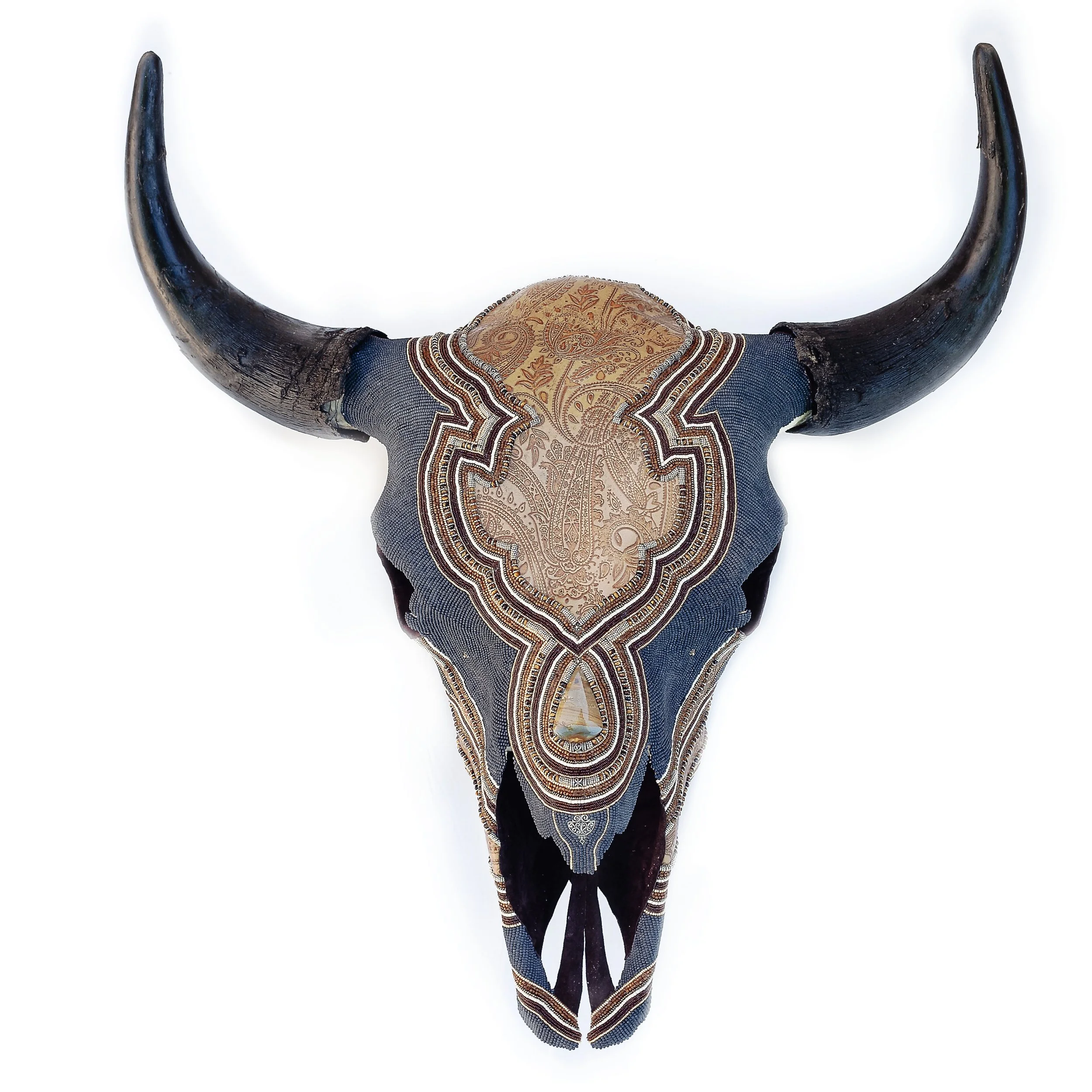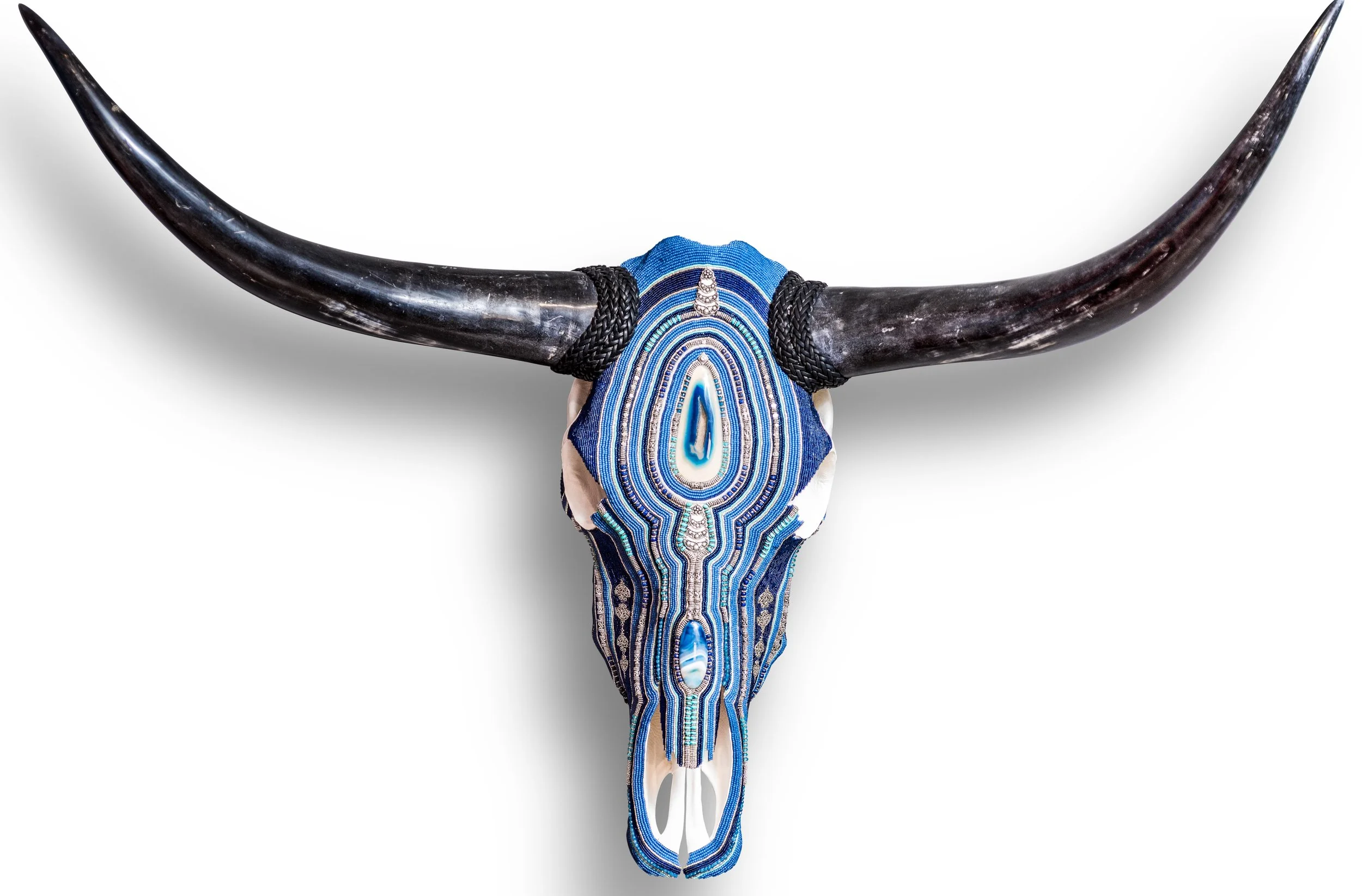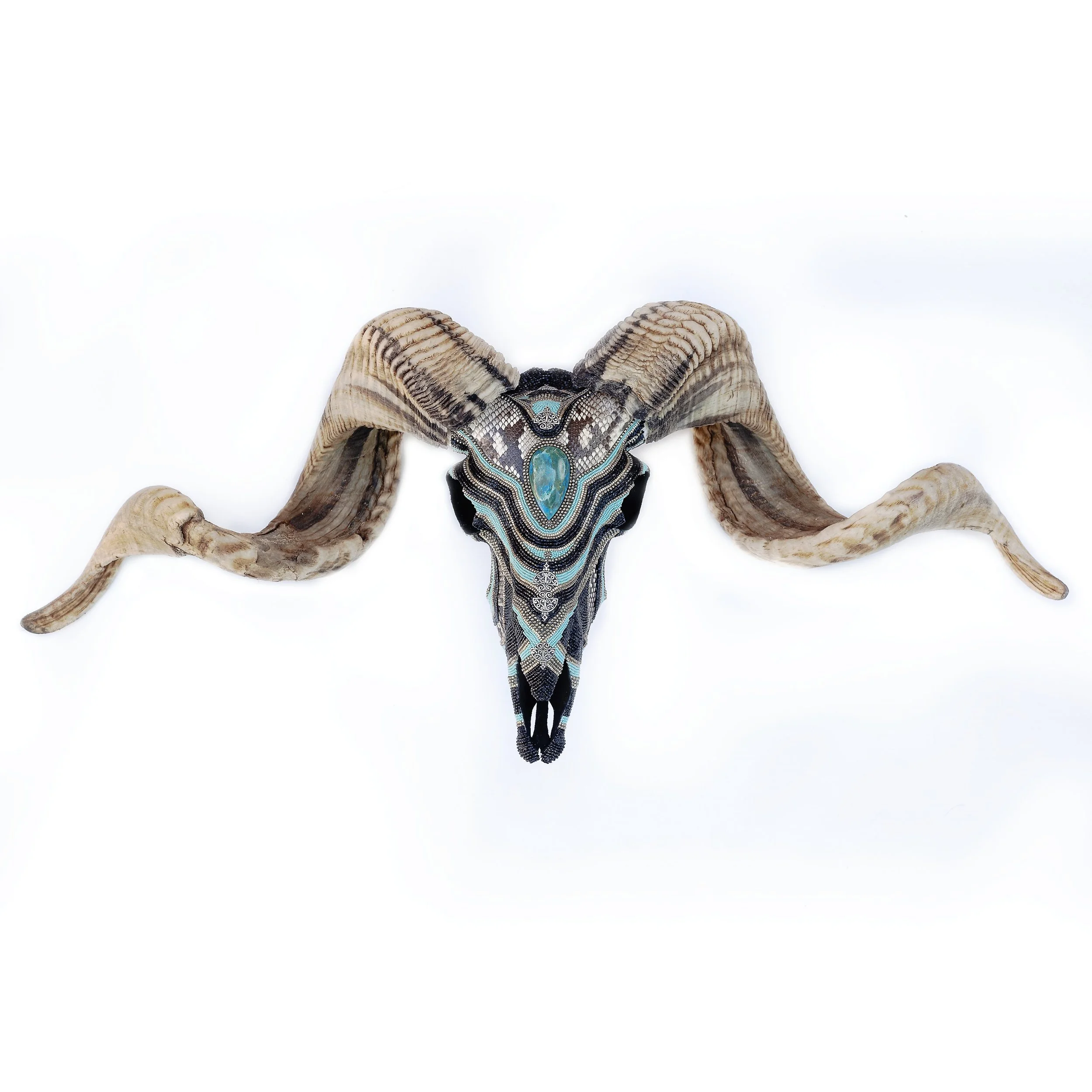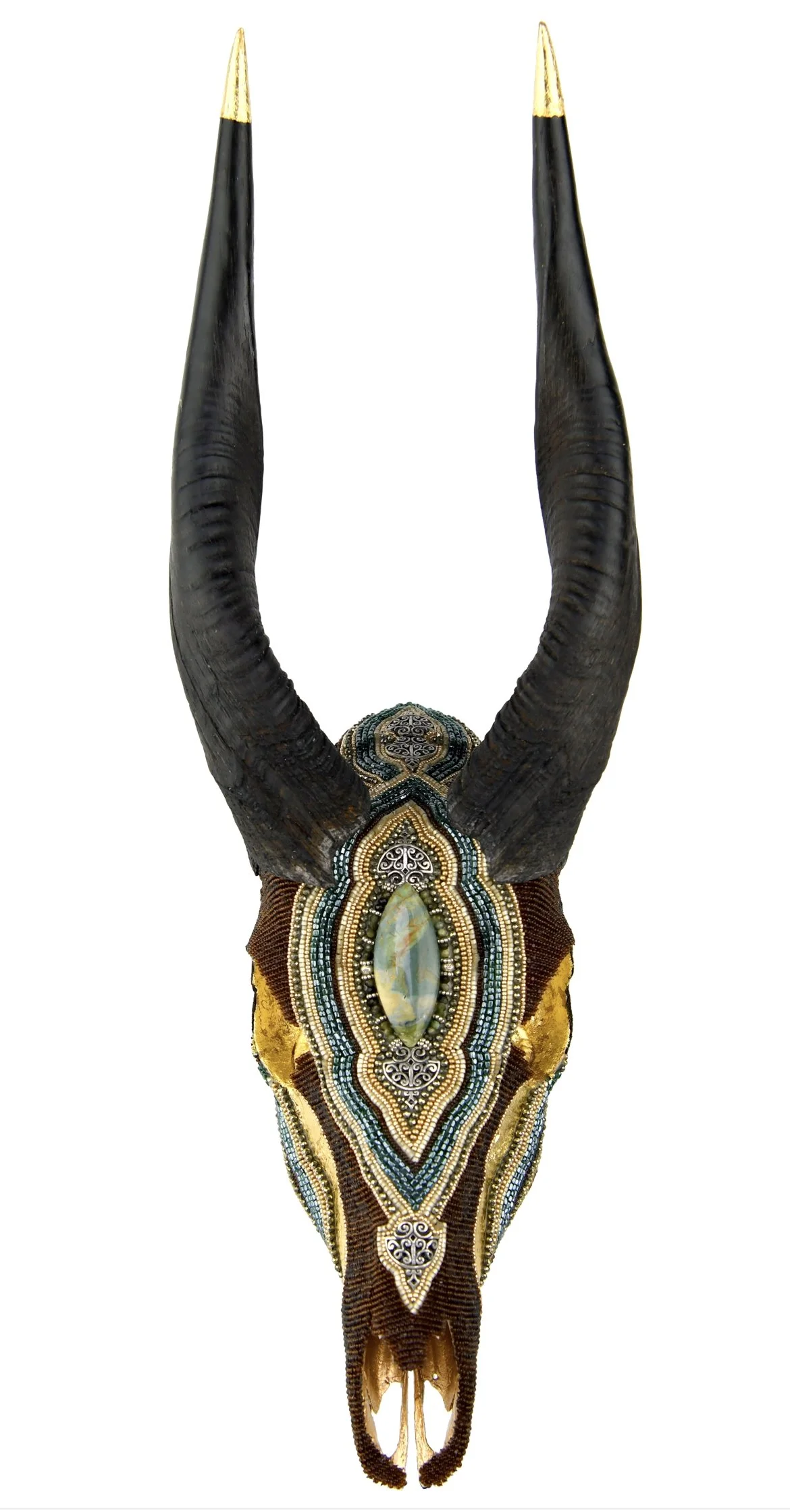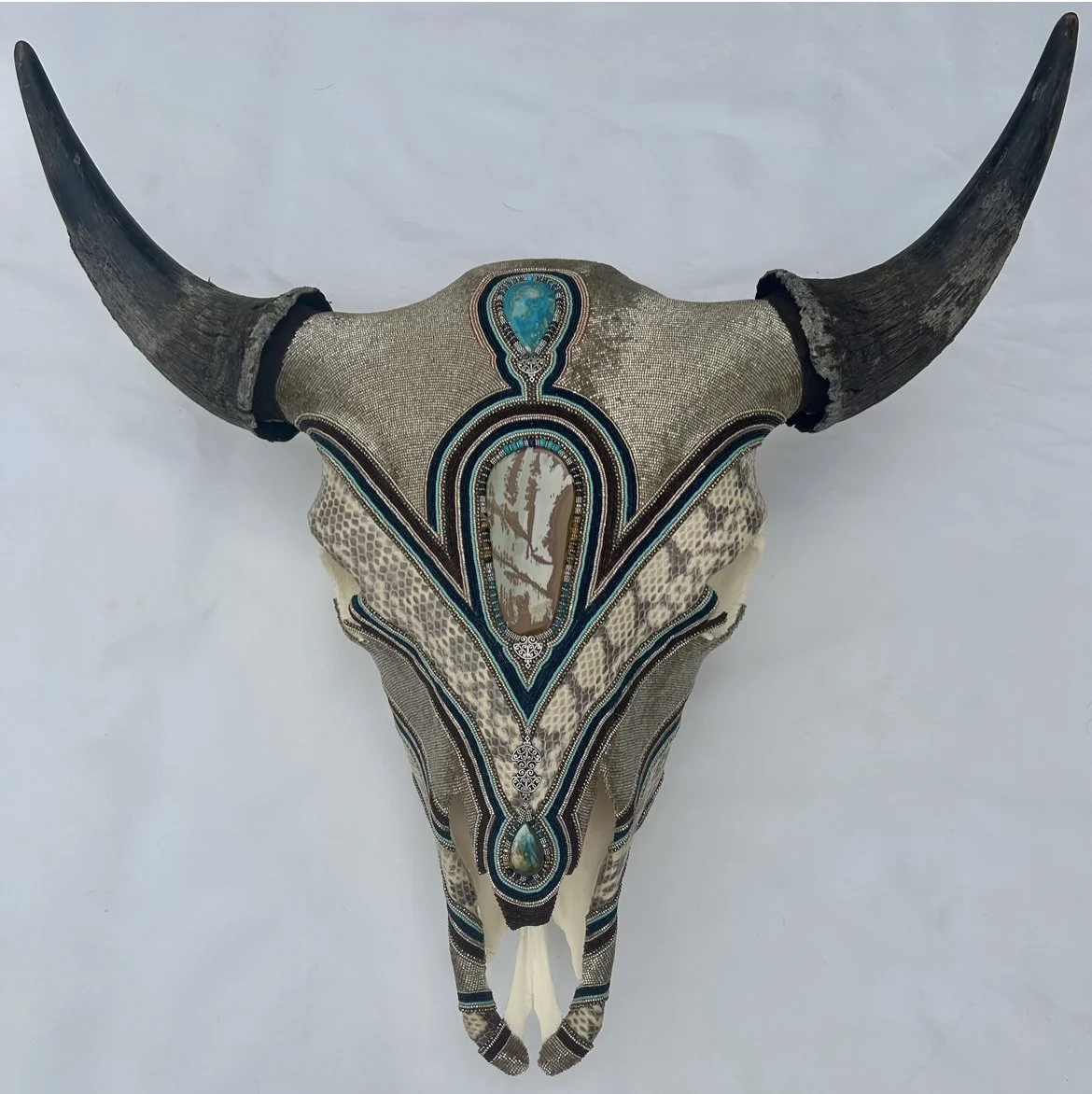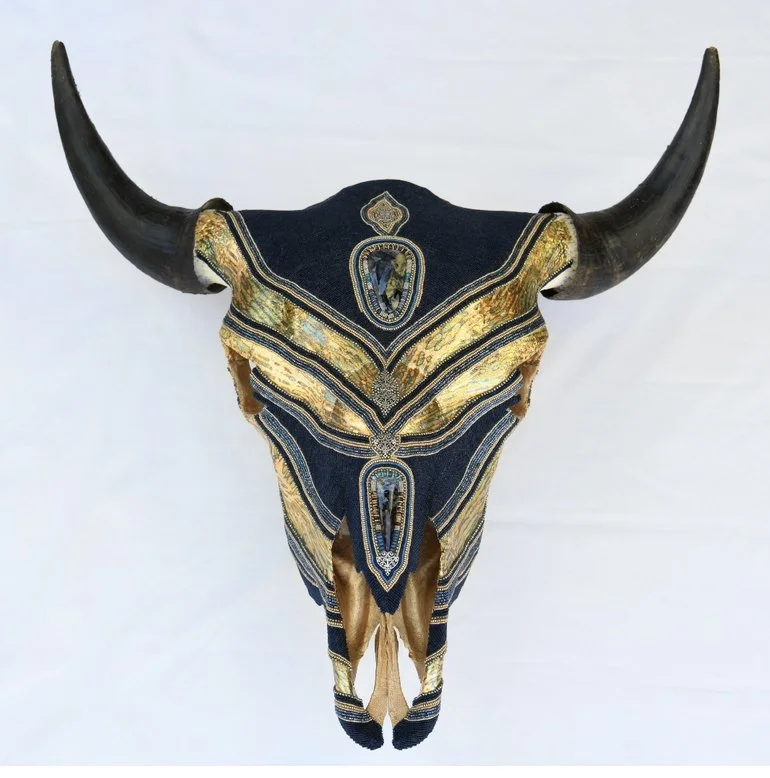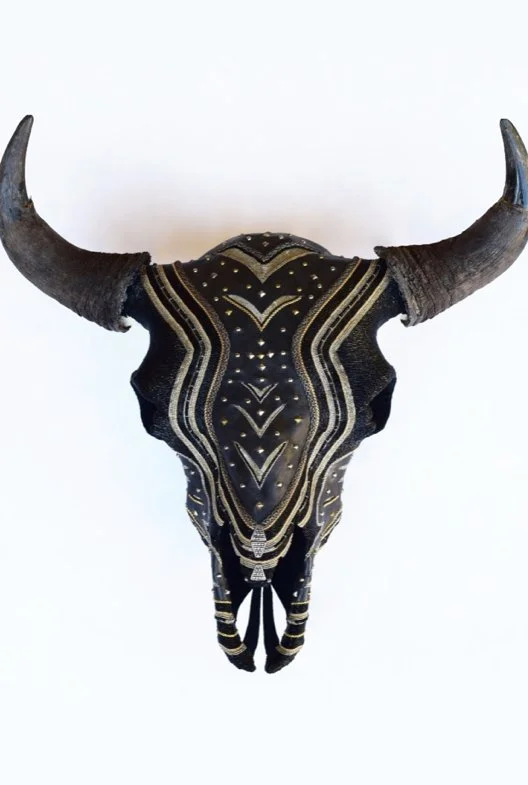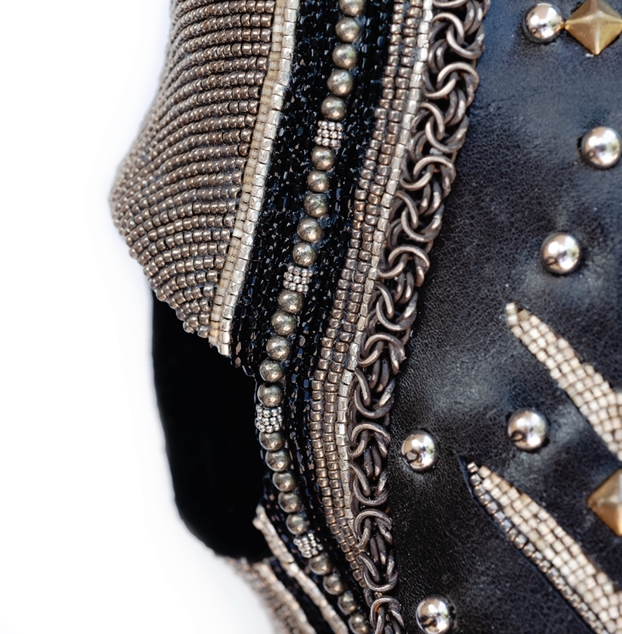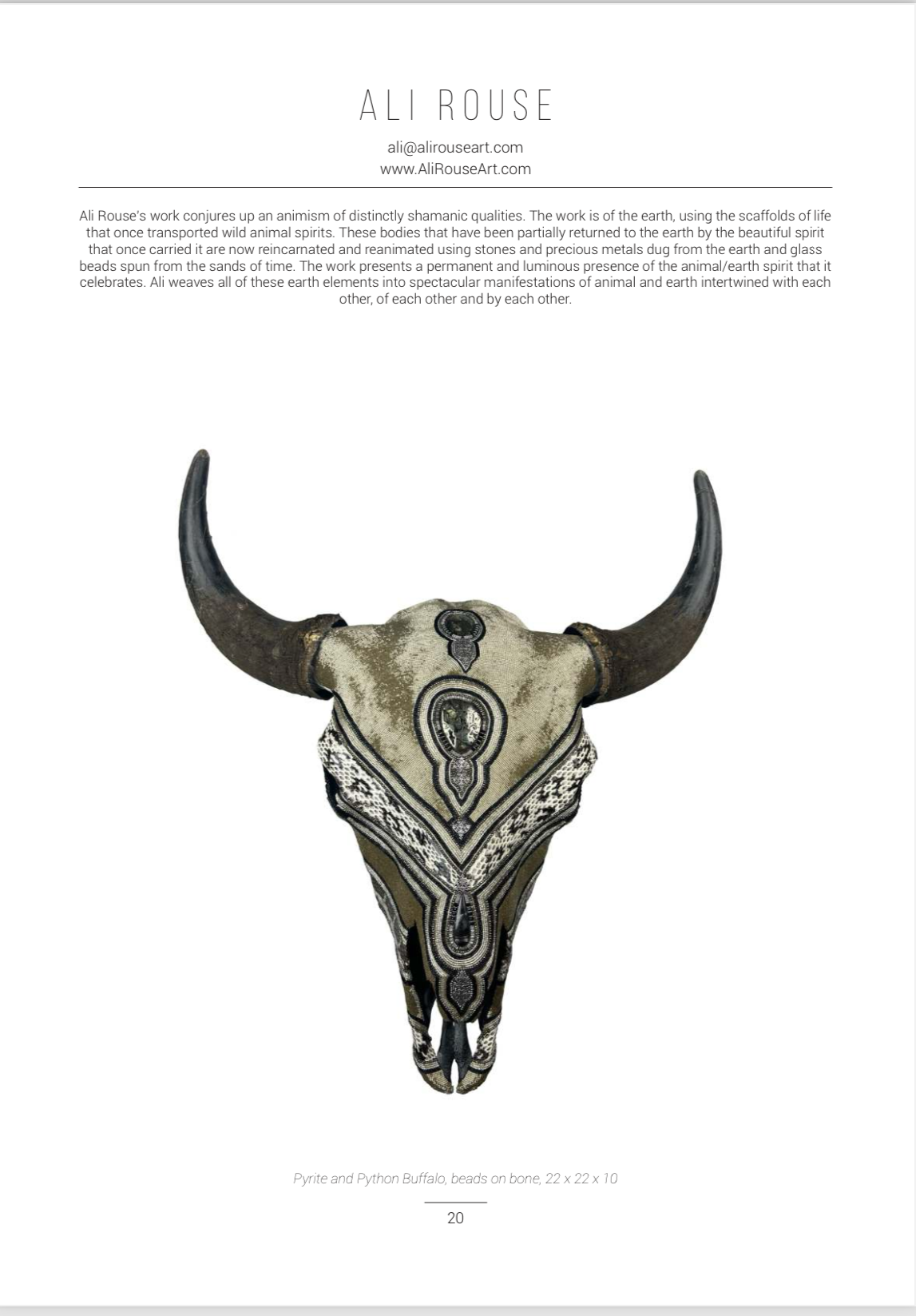Ali Rouse
Ali Rouse's artistic creations are a profound reflection on the concepts of animism, shamanism, and the eternal cycle of life, death, and rebirth. Her work presents an awe-inspiring symbiosis between animal remains and ornate craftsmanship, giving new life to what was once part of the wild. Each piece is a tribute to the spirit of the animal and the materials sourced from nature, interweaving them into a complex narrative of existence, transformation, and permanence.
Rouse's artwork embodies a shamanic essence, reminiscent of ancient practices where the line between the spirit world and the earthly realm was interlaced with ritual and respect for all living things. The use of animal skulls, adorned with stones, precious metals, and intricate beadwork, transcends mere artistic expression; it becomes a vessel for the soul of the animal, the energy of the earth, and the hands of the artist. The animals, though no longer living, are given a new form of immortality, a celebration of their past vitality captured through the visual splendor of Rouse's craft.
The detailed beadwork on the skulls, meticulous and deliberate, mirrors the ancient civilizations' reverence for the natural world. These adornments evoke the meticulous glyphs and patterns found in the remnants of civilizations such as the Mayans or Egyptians, who also believed in the cyclical nature of life and the importance of preparing for the journey after death. Rouse's work prompts the viewer to contemplate the beliefs of these ancient cultures, the reverence they held for the creatures with whom they shared the earth, and the messages they left behind regarding the intertwined destinies of man and beast.
In contemporary society, where the spiritual connection to nature is often overshadowed by technological advancement and material pursuits, Rouse's art brings an important message. It calls on the observer to remember the sacred circle of life, the inevitability of death, and the possibility of rebirth in different forms. The use of earth elements such as stones and beads is a tangible reminder of our roots and the finite nature of our existence.
The animal skulls, each unique in shape and story, serve as a canvas for Rouse's intricate work, which not only symbolizes the animal's spirit but also represents the greater energy cycle. This cycle is uninterrupted and fluid, moving through various states and forms. The incorporation of such opulent materials reminds us of the preciousness of life and the beauty that can be found even after the spirit has departed. It's a dialogue between the past and the present, a lesson from ancient traditions that life, in any form, should be honored and celebrated.
Rouse's art imparts wisdom on multiple levels. Firstly, it embodies the idea of reincarnation, not in the literal sense of a soul returning in a new body, but in the symbolic preservation of energy and spirit in a new form. The skulls, once part of living creatures, become art, thereby ensuring that the animal's essence continues to inspire and influence the world. This notion resonates with many spiritual beliefs that see death not as an end but as a transformation, a new beginning of sorts.
The pieces speak of the integral connection between all forms of life and the natural world. In today's age of environmental concern, they can serve as a poignant reminder of our responsibilities towards nature. By celebrating the animals in such a dignified and majestic way, Rouse's work can inspire a deeper respect for the myriad forms of life that we share our planet with.
Ali’s art teaches the value of beauty and craftsmanship. In a world where mass production has become the norm, Rouse's painstakingly handcrafted pieces stand out as testaments to human creativity and the unique beauty that can be achieved through time-honored skills. They celebrate the artist's hand at work, the slow and thoughtful process of creation, which in itself is a life-affirming act.
Ali Rouse's artwork is an homage to life's perpetual flux, the ancient wisdom of our ancestors, and the enduring spirits of the creatures that walk, fly, and swim beside us. Her work does not shy away from the subject of death; instead, it confronts it with a dignified beauty, prompting a reawakening of the reverence that is due to all beings in life and in death. It carries the important message that beauty and spirit are eternal and that they survive long after the physical has returned to the earth. In this sense, her art is not just a visual experience but a spiritual journey that encourages us to see the world, and our place within it, through a lens of wonder, respect, and eternal continuity.
Ali Rouse's art is a philosophical meditation on the cycle of life, offering a tangible representation of reincarnation and the undying spirit. Each piece functions as a contemplative artifact, encouraging the observer to delve into the mysteries of existence, death, and rebirth.
The philosophy embedded within these creations is one of continuity and impermanence. Life is not viewed as a linear journey with a definite beginning and end, but rather as a cyclical process. In many traditions, the circle is a sacred symbol representing unity, wholeness, and eternity. Rouse's art embodies this philosophy by taking something that has reached the end of its earthly journey—the skull of a once-living creature—and beginning it anew in a different form. The skull, which housed the mind and spirit, becomes the seed for a new type of life, one that is artistic and static yet vibrant in its visual narrative.
In shamanic cultures, it's believed that everything has a spirit. Rouse's work gives a nod to this animistic view, where animals, stones, and even colors possess a life force. The art resurrects the spirit of the animal in a visible and tangible way, suggesting that death is not the cessation of life but a transformation into another state of being. This mirrors the concept of reincarnation, where the soul, after death, begins a new life in a new body—a cycle of continual regeneration. Rouse's art suggests that energy never dies; it only changes shape and continues in different forms and manifestations.
These artistic expressions are reflections on the impermanence and transitory nature of existence. In Buddhism, the notion of impermanence is central, with the understanding that all things are in a constant state of flux. Rouse captures this transience, presenting not decay but transformation, not end but continuation. Her artwork resonates with the teachings of many spiritual traditions that life's temporary nature should not be a source of sorrow but a call to appreciate the here and now, to recognize the interconnection of all life forms, and to celebrate the ongoing dance of existence.
The life philosophy that Rouse's art imparts also speaks to the concept of rebirth within ourselves—our capacity to transform our lives and spirits through experiences, learning, and personal growth. Each skull, in its ornate resurrection, serves as a metaphor for personal evolution and the human ability to reinvent and renew. It underscores the belief that we, too, are part of nature's grand cycle, evolving and adapting in response to our experiences.
This cycle of life, death, and rebirth is also a powerful allegory for the potentiality within each ending. In every conclusion lies the seed of a new beginning, a perpetual promise that nothing is ever truly lost but is reborn in different forms. Rouse's work teaches us to honor the past, to acknowledge the present, and to be open to the future's transformations. It encourages a reverence for the natural world and a deeper understanding of our own lives as part of the grand tapestry of existence.
The art of Ali Rouse serves as a visual and philosophical exploration of life's great cycle. It prompts introspection on the nature of our being, the interconnectedness of all life, and the beautiful complexity of the world. It celebrates the ever-present possibility of new beginnings, even from the remains of what once was, and underscores a profound truth—that in every end is the whisper of a new start, echoing the eternal rhythm of the universe.
Ali Rouse emerges in the contemporary art scene as an avant-garde alchemist of form and spirit, positioning herself at the confluence of fine art, craftsmanship, and a revived animistic philosophy. Her work is not just a passive visual experience; it is a catalyst for introspection and spiritual dialogue, harking back to ancient civilizations while addressing the zeitgeist of environmental and spiritual consciousness in contemporary culture.
Rouse's distinctive artistry has carved out a unique niche in the realm of sculptural and conceptual art. By choosing to work with organic materials that bear the weight of life's histories, she ties her practice to a lineage of artists and shamans who see the role of art as a bridge between the seen and unseen worlds. Her creations find resonance not only among those with an appreciation for their aesthetic merit but also among individuals seeking deeper connections to nature and spirituality.
Her presence in the art world can be likened to that of a modern-day shaman, using her art to communicate with the spirit of the animal, to honor it, and to share its story with the world. Each of her pieces can be viewed as a totemic sculpture, a physical manifestation of the life force that once inhabited the bones she so intricately adorns. In a society that often neglects these connections, Rouse stands as a reminder and a restorer of a bond that is both ancient and deeply needed in our modern times.
The philosophical depth of her work places her among contemporary artists who challenge the viewer to reconsider the relationship between humanity and the more-than-human world. Rouse's reanimated creations serve as relics of a modern culture seeking to rediscover and redefine its connection with the natural world. The skulls, adorned and transformed, prompt a conversation about the sanctity of life and the value of remembrance, asking the viewer to consider the often overlooked beauty inherent in life's ephemeral nature.
In terms of the art scene, Rouse’s pieces are more than just objects of beauty; they become altars of contemplation. They may be aligned with the environmentally conscious art movement, yet they transcend simple categorization, embodying the roles of cultural artifacts, spiritual emblems, and conservationist statements. Her art can teach us about life's philosophy, its cycles, and the notion of reincarnation not in the literal sense but as a metaphor for the continuity of energy and spirit.
By bringing together the primal and the refined, the earthly and the ethereal, Rouse's works command a unique space in galleries and collections. They appeal to collectors seeking more than mere aesthetic; they attract those in pursuit of pieces that encapsulate broader existential themes and reflect personal and collective mythologies. In the context of the global art market, her work could be both a sanctified object of contemplation for the individual home and a provocative centerpiece in public spaces, catalyzing discourse on life, death, and the impermanence of form.
Ali Rouse's work is an antidote to the rapid digitalization and disconnection in contemporary society. Her artistic philosophy suggests a circular view of existence, where death is not the opposite of life but a part of it. Her work is an invitation to embrace the cycle of life, to acknowledge the permanence of the spirit beyond the physical, and to respect the past lives that continue to shape our present. As such, Rouse's work serves as a bridge from the ancestral past to the current consciousness, reminding us that art can be a powerful medium for the transmission of timeless truths and sacred narratives.
By Marta Puig
Editor Contemporary Art Curator Magazine

